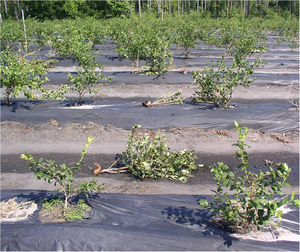Microplastics
Overview
Most commonly studied for the detrimental effects caused in marine environments, the impacts of Microplastics on soil ecosystems have been largely neglected [1]. The main sources of microplastic pollution in soil is thought to be plastic mulching film and fertilizer produced through waste water irrigation [2].
Plastic Mulching

Plastic mulch is used to conserve water and subdue weed growth in agriculture. Conventional plastic polymers are typically used as biodegradable alternatives are usually much more expensive [3]. Plastic polymers tend to accumulate in soil as it is broken down due to lack of economical and legal incentive surrounding removal of plastic mulching [1].
Buildup of Microplastics Due to Fertilizer Application
Wastewater facilities receive a large amount of microplastic fibers emitted from industry, surface run-off, and households in urban areas. A surprisingly large amount may come through use of washer machines [4]. Most of these fibers accumulate in sewage sludge, which is often turned into a fertilizer. While there are regulatory methods on the possible pollutants in waste water sludge, there remains none regarding the accumulation of microplastics.
Potential Impacts on Plant and Soil Health
Refrences
[1]. Defu He, Yongming Luo, Shibo Lu, Mengting Liu, Yang Song, Lili Lei.(2018).Microplastics in soils: Analytical methods, pollution characteristics and ecological risks.TrAC Trends in Analytical Chemistry.163-172.0165-9936.https://doi.org/10.1016/j.trac.2018.10.006.
[2]Rillig,M.C.(2012).Microplastic in Terrestrial Ecosystems and the Soil?.Environ.Sci.Technol. 46 (12), 6453– 6454, DOI: 10.1021/es302011r
[3]Nizzetto et al (2016): “A theoretical assessment of microplastic transport in river catchments and their retention by soils and river sediments” in Environ. Sci.: Processes Impacts, 2016, 18, 1050-1059. DOI: 10.1039/C6EM00206D
[4]Nizzetto, Futter, Langaas (2016): “Are Agricultural Soils Dumps for Microplastics of Urban Origin?“ in Environ. Sci. Technol. DOI: 10.1021/acs.est.6b04140